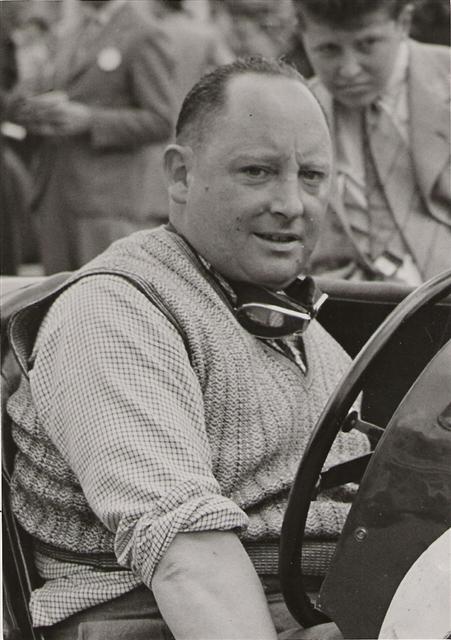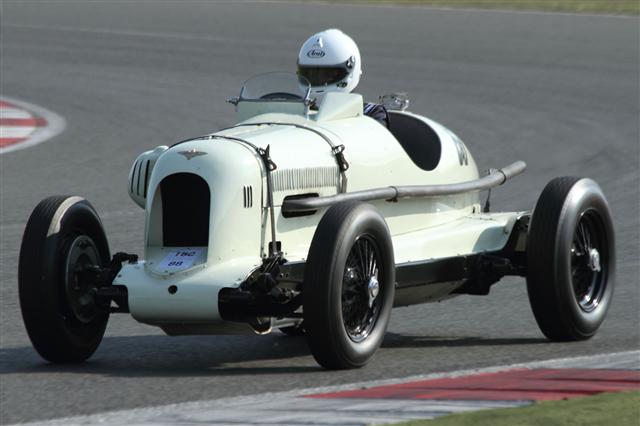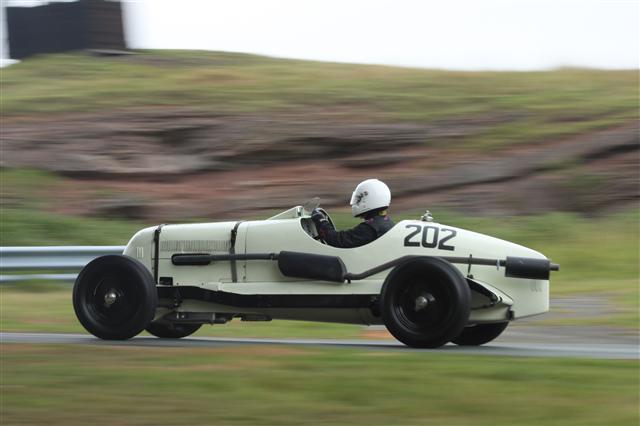Lagonda Rapiers
This page concentrates on the Lagonda Rapiers that make up part of our collection. The interest in Lagondas comes mainly from Tim's family.
Click on the links below to see the sections on each car
Click on the links below to see the sections on each car
Jane Metcalfe on the way to 2nd place in the Eccles Rapier - Silverstone April 23 2011 (photo Mark Ballard)
The Eccles Rapier is the most successful and famous racing Lagonda Rapier of them all. Roy Eccles, for whom the car was originally built, was introduced to motor racing by his Bugatti driving younger brother Lindsay. He enjoyed a varied early racing career driving Frazer-Nash, Alta, Riley, and MG, including finishing fourth at Le Mans in 1934 driving a K3 MG. Having sampled the major small capacity opposition his decision to order a Rapier in late 1934 in order to try and beat them at Brooklands and elsewhere was obviously after some considered thought as this was by no means the cheapest or easiest option.
Roy Eccles in the Eccles Rapier in 1936
Legend has it that Eccles' Rapier chassis was smuggled out of the back door of the Lagonda factory as the Receiver was coming in the front door. Various engine modifications were undertaken by McEvoy’s of Derby, including revised cylinder head cooling, stroking to reduce capacity to 1084cc and the fitting of a large supercharger. A lightweight offset single-seat body was also fitted finished in a cream colour.
The finished car, now styled the “Eccles Supercharged Special” was entered for the BARC Whitsun meeting at Brooklands on 10th June 1935, but it was not finished in time. Instead Roy's first outing was at the British Empire Trophy Race at Brooklands on 6th July 1935, where unfortunately the car only completed 49 laps of the 80 lap race.
The finished car, now styled the “Eccles Supercharged Special” was entered for the BARC Whitsun meeting at Brooklands on 10th June 1935, but it was not finished in time. Instead Roy's first outing was at the British Empire Trophy Race at Brooklands on 6th July 1935, where unfortunately the car only completed 49 laps of the 80 lap race.
Roy Eccles (16) 1935 British Empire Trophy Race, Brooklands
Roy Eccles (number 7) at the start of the 1935 Siam Trophy race at Brooklands
The 1935 Siam Trophy race at Brooklands - the Eccles Rapier is number 7
Brooklands success was not long in coming as Roy won his first Brooklands Outer Circuit race at an average of 104mph at the 1935 August Bank Holiday meeting. However, the Brooklands authorities were somewhat concerned at the car being described as the “Eccles Supercharged Special” when it was so obviously a Lagonda Rapier and they wrote to Lagonda to request clarification. By then Lagonda had other things on its mind with receivership and transfer of Rapier production to Rapier Cars Limited. Following modifications over the 1935/36 winter carried out by Robin Jackson at Brooklands, including swapping the throttle pedal over to the right hand-side, modified bodywork and new dampers to cope with the Brooklands bumps, the car reappeared for 1936 styled as a Rapier Special and sporting the Rapier badge from the newly formed Rapier Cars on its radiator cowl.
Eccles Rapier in Robin Jackson's worshop at Brooklands 1936/37
Roy had to wait until the August Bank holiday meeting for further Brooklands success in 1936 when he again won on the Outer Circuit at an average of 108.8mph and also dead-heated with King-Clarke's MG for a win on the Mountain Circuit. A further win on the Mountain Circuit in early 1937 was followed by a win on the newly opened Campbell Road Circuit at Brooklands in October, which also saw Roy take the 1100cc Campbell Circuit lap record. This showed the true versatility of the Rapier with it having won on all three of the main Brooklands circuit configurations.
Roy Eccles' dead heat with King-Clarke's MG at Brooklands in 1936 captured by Bryan de Grineau
Roy Eccles in the Eccles Rapier at Donington in 1936
In all Roy and his wife Marjorie competed in over 20 races at Brooklands in the Rapier, before Roy's untimely death from a brain haemorrhage at the age of 37 in early 1938. Roy and Marjorie also enjoyed success with the Rapier at Donington, Shelsley Walsh, Brighton, the Isle of Man and notably a big crash for Marjory on the first lap of the 1937 London Grand Prix at Crystal Palace, when she rolled the car having previously caused consternation by jumping the start.
Marjorie Eccles, Eccles Rapier, 1937 London Grand Prix, Crystal Palace
Marjorie Eccles, Brooklands 14th March 1936
Marjorie Eccles on the grid at Brooklands in 1936, why are some cars facing the wrong way?
Marjorie Eccles, Brighton Speed Trials, September 25th 1937
Marjorie Eccles relaxing on the Rapier 1935
Roy Eccles winning at Brooklands in 1937 covered by Pathe News
Donington starting grid in 1936/37 for a handicap race, Roy Eccles in the Rapier back left
The Rapier was to race one last time at Brooklands in September 1938 when Marjorie entered the Dunlop Jubilee races for Rapier Cars Director, Neville Brocklebank, unfortunately without success.
With Brooklands closing on the outbreak of war in 1939 the Rapier passed to car dealer Ian Metcafe who was to store it for the duration at his mushroom farm. With the ending of hostilities the first post war British race meeting was organised at Gransden Lodge on 15 June 1946. Ian Metcalfe dusted off the Rapier and joined an assortment of eight cars in the main Voiturette race of the day. Ian continued to race the car for the next two years, most notably qualifying on the second row at Rheims for the 1947 Coupe de Petites Cylindrees, lapping quicker than the likes of Louis Chiron and Maurice Trentignant in more modern Gordini and Cisitalia. Unfortunately various problems let Ian down and after an eventful race he was to be the last classified finisher in 11th.
The Eccles Rapier outside Ian Metcalfe's garage, Walton on Thames 1947
Ian Metcalfe with the Eccles Rapier at the Manx Cup on the Isle of Man in 1947
Ian Metcalfe, Eccles Rapier (number 2), Rheims, 1947 Coupe de Petites Cylindrees
From Ian's hands the car passed to HWM where Fred Hobbs ran it at Goodwood and elsewhere, but it was no match for the more modern 1100cc Cooper opposition, particularly driven by the likes of Stirling Moss. However, HWM did take advantage of some of the spares acquired with the Rapier, which were incorporated into a number of their early cars.
Fred Hobbs, Eccles Rapier, 1949 Goodwood Easter Monday Meeting
From the early 1950's the car continued to be seen frequently in historic racing, sprints and hill climbs, most notably in the hands of Alex McCall who owned the car from the early 1960's until his death in 2001.
Vickers Jones in the Eccles Rapier in 1955
Alex McCall in the Eccles Rapier at VSCC Prescott in 1975
Following the acquisition of the Eccles Rapier by Tim Metcalfe in 2001 it was recommissioned for track use and soon winning in VSCC competition. However, the car had never been fully rebuilt since 1935 and was getting somewhat tired. It has therefore just finished a three year sympathetic rebuild by Tony Metcalfe and is back painted cream for the first time since the winter of 1935.
The Eccles Rapier back at Brooklands in 2009
Tim Metcalfe winning at Silverstone in the Eccles Rapier - 23 April 2011 (photo Mark Ballard)
Jane Metcalfe, Eccles Rapier, 2010 VSCC Loton Park (photo Mark Ballard)
Tim Metcalfe, Eccles Rapier, Santa Pod 2014
"The Great Lagonda Race", Oulton Park 2010, won by Tim Metcalfe in the Eccles Rapier
Chassis Number: D11184
Engine Number: D2934
JY 4416 was, supplied by Delafield of Plymouth in October 1934. The first owner was Lt. Commander Arthur Orpen of the Royal Navy, who at that time was serving aboard HMS Delhi, whose home port was Devonport.
Arthur had obviously thought long and hard about his purchase of the Rapier as his correspondence with Thomson and Taylor of Brooklands illustrates. Interestingly JY 4416 now incorporates the higher compression and larger carburettor upgrade suggested.
Arthur Orpen with JY 4416 in Ireland in October/November 1934
Arthur Orpen's plans for the arrival of JY 4416 in Ireland 28 October 1934
The car's immediate post war history is unknown, however, needing an extensive rebuild it was dismantled in the early 1960’s, probably following the advice of Wheatley and Morgan in the first chapter of their famous book “The Restoration of Vintage and Thoroughbred Cars”. Unfortunately the then owner seemed to have progressed no further than chapter one and the car remained in pieces until purchased by the current owner in 1998.
With the purchase the aim was to rebuild the car into a fast two-seat, road-going Rapier, utilising a copy of an original body that could happily cruise at modern motorway speeds. After much deliberation it was decided to rebuild the body as an accurate replica of Lord de Clifford’s 1934 Le Mans body, the build of which was undertaken alongside the rebuild of the original Le Mans car’s body. This offered a light weight two-seater with plenty of driver and passenger protection and importantly a large fuel tank for long distance touring.
The rebuild was completed by Tony Metcalfe in 2001 and the car was ready for action. Initial rolling road tests showed over 100 bhp at the rear wheels at 5500 revs and road testing proved that the car was easily capable of 70 mph plus sustained cruising on original sized 4.50/19 inch tyres, with a genuine 100 mph possible with the windscreen folded flat.
With the purchase the aim was to rebuild the car into a fast two-seat, road-going Rapier, utilising a copy of an original body that could happily cruise at modern motorway speeds. After much deliberation it was decided to rebuild the body as an accurate replica of Lord de Clifford’s 1934 Le Mans body, the build of which was undertaken alongside the rebuild of the original Le Mans car’s body. This offered a light weight two-seater with plenty of driver and passenger protection and importantly a large fuel tank for long distance touring.
The rebuild was completed by Tony Metcalfe in 2001 and the car was ready for action. Initial rolling road tests showed over 100 bhp at the rear wheels at 5500 revs and road testing proved that the car was easily capable of 70 mph plus sustained cruising on original sized 4.50/19 inch tyres, with a genuine 100 mph possible with the windscreen folded flat.
JY at Brooklands in 2008
However, the first real test for the car came in the 2004 Vintage Sports Car Club Pomeroy Trophy held annually in February at Silverstone. Laurence Pomeroy presented the trophy to the VSCC in 1946 with the aim of establishing an annual competition to identify the “ideal touring car” by means of a series of tests and follow up calculations. The tests cover cornering, braking, acceleration and driving at speed for forty minutes. The Rapier has repeatedly proved its worth annually in the “Pom” against over one hundred other cars built over the last 100 years, winning a first class award for five years in succession.
JY competing in the VSCC Pomeroy Trophy at Silverstone 2005
JY 4416 has now covered over 10,000 road miles since its rebuild and is regularly used for travel to social events and even the odd business meeting. It has also been used for occasional competition and has proved to be a very usable and reliable road car, with the only problems being a blown head gasket and a fuel pump failure despite many spirited miles of driving.
JY ready for the off, Woodbridge 2008 (photo Ann Pilgrim)








































